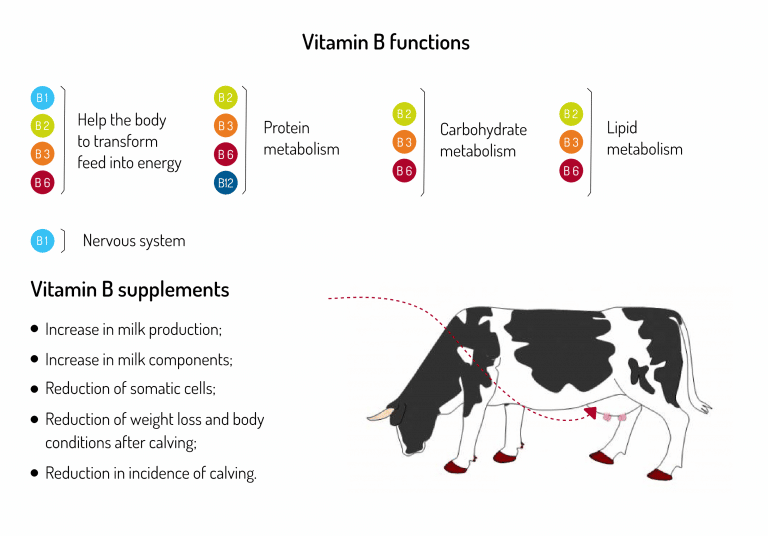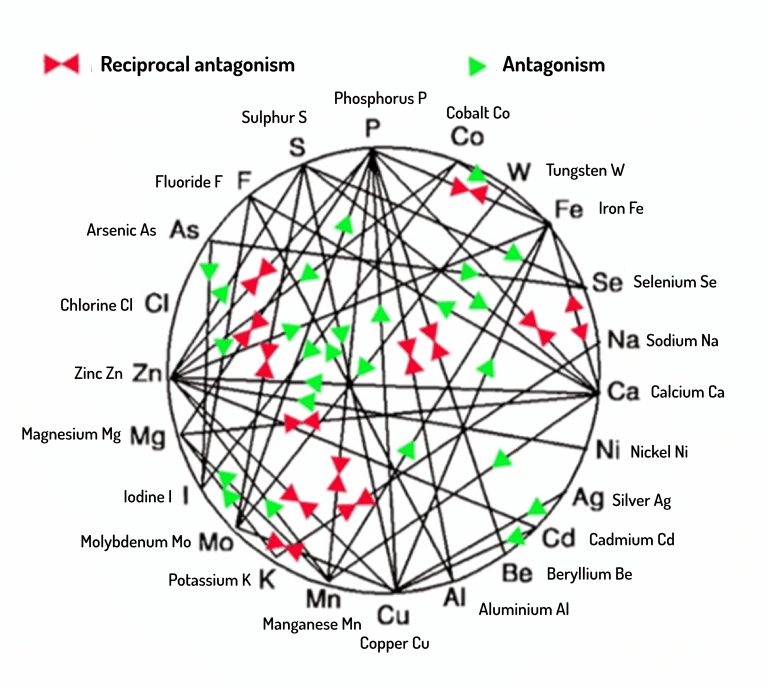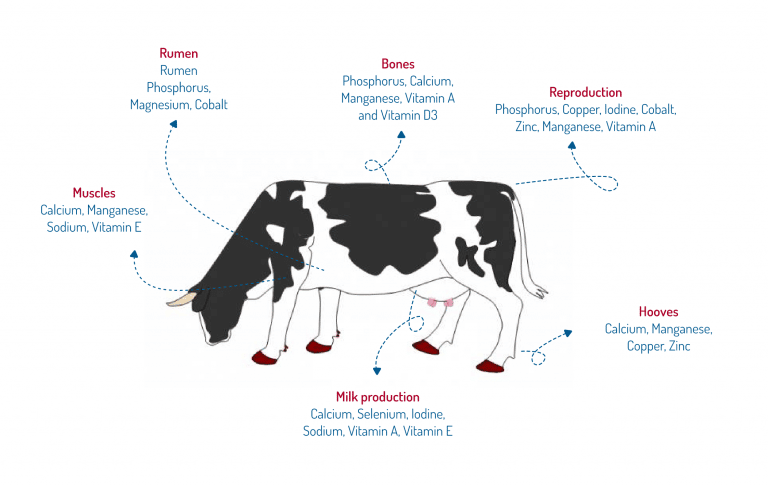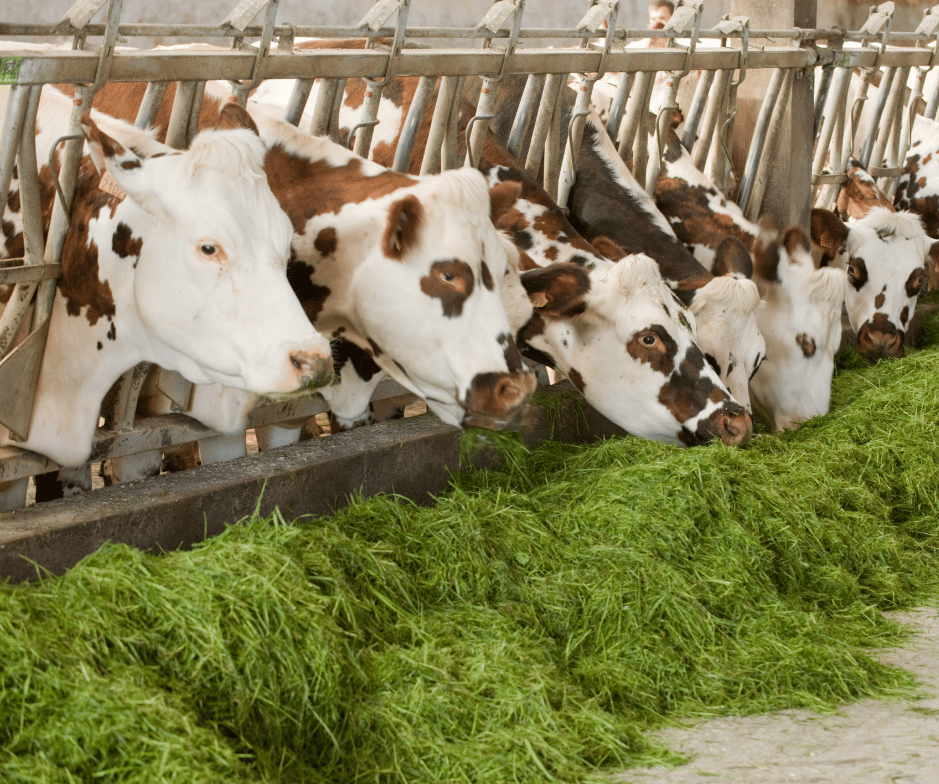Cattle are fed primarily on various types of fodder:
- Fresh;
- Ensiled;
- Hay.
However, to compensate for the limited energy inputs of these types of fodder, the use of feed supplements is essential to meet their needs. These provide real added value, because in addition to enhancing the animals’ wellbeing, feed supplements also significantly accelerate the animal’s performance and capacity.
Vitamins
Vitamins are known to play a key role in ruminant health (production, reproduction, calving, immunity). Moreover, current dietary regimes do not meet all their needs, it is therefore necessary to supplement their diet with feed supplements.
Vitamins are essential for the growth and functioning of the body. Each vitamin provides additional benefits and fills the nutritional gaps of cattle. There are 2 main vitamin groups:
- Liposoluble vitamins (soluble in fats);
- Hydrosoluble vitamins (soluble in water).
These have different functions:
- Liposoluble vitamins play a specific role in the development and maintenance of tissue structures;
- Hydrosoluble vitamins, in particular the B vitamins, are involved in metabolic functions (co-enzymes).
But how can you identify deficiency symptoms in your animal? Deficiencies are identified by various symptoms, in particular:
- Loss of appetite and loss of weight;
- Reduction in growth, performance, reproduction;
- Anorexia, convulsions;
- Diarrhoea, dehydration.
Focus on B vitamins
B vitamins are present in small quantities in feed. There are eight B vitamins:
- Thiamin (B1);
- Riboflavin (B2);
- Niacin (B3);
- Pantothenic acid (B5);
- Vitamin B6;
- Biotin (B8);
- Folic acid (B9);
- Vitamin B12.
Each of these has a distinct structure and functions.

Focus on vitamin C and vitamin E
Vitamin C is an antioxidant that plays a key role in immune function. The main roles of vitamin C lie in its oxidation-reduction capacity, which gives it the following benefits:
- Its antioxidant capacity;
- Its role in Vitamin E recycling;
- Its capacity to make Iron more bioavailable (may play a role in replenishing red blood cell stores after calving and possibly in cases of mild anaemia);
- Its support for immune functions by protecting neutrophils from free radicals.
Vitamin E is essential for the integrity and functioning of the reproduction muscles, blood and lymphatic circulation, and the nervous and immune systems.
Trace elements
The trace elements are all linked. A deficiency or excess in trace elements can cause numerous problems in a herd, with a “domino” effect.
Trace elements are involved:
- In the production of enzymes;
- In the composition of vitamins and hormones;
- In immune defence;
- In the control of oxidative stress.
Each farm is unique. This is because soils, diets, fodders and production levels are not the same everywhere. A mineral formula cannot therefore be the same for Les Deux-Sèvres, La Meuse and Le Cantal.
A trace element analysis can be used to tailor the mineral approach to your farm.
Do you know the role of each trace element?
There are numerous interactions (antagonism or synergy) between the various minerals and with other elements (vitamins, amino acids) that affect their digestibility.
The diagram below shows all the antagonisms between trace elements:

To conclude, feed supplements are used not only to prevent deficiencies. The right intake of minerals, trace elements, vitamins and plants contributes to the development of the mammary gland, promotes growth, aids calf development and maintains immune system function. Therefore, a dietary programme that aims to provide optimal quantities of minerals and vitamins will contribute to the health and productivity of your animals.

Sources:
- MiXscience: www.mixscience.eu/especes/ruminants/
- AGROMedia: www.agro-media.fr/secteur-activite/aliments-du-betail
- Web-agri: www.web-agri.fr/sondages-elevage/article/144962/apporter-un-cmv-adapte- pour-eviter-les-carences-sans-tomber-dans-l-exces
- Internal Difagri source (sales information & technical sheets)


